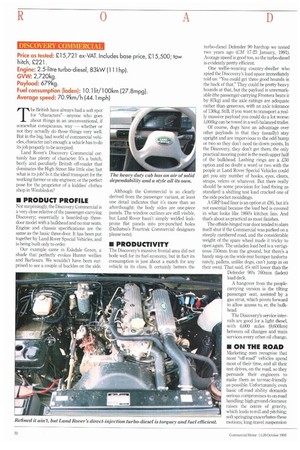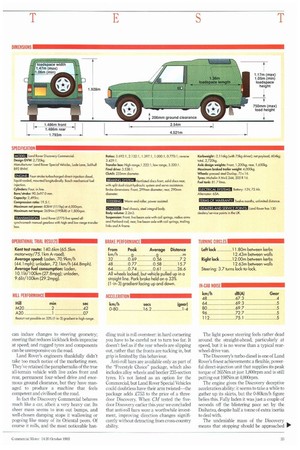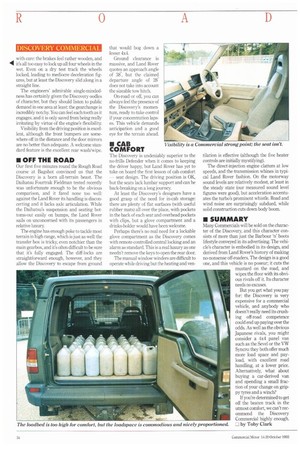T he British have always had a soft spot for "characters"—anyone
Page 34

Page 35

Page 36

If you've noticed an error in this article please click here to report it so we can fix it.
who goes about things in an unconventional, if somewhat conspicuous, way — whether or not they actually do those things very well. But in the big, bad world of commercial vehicles, character isn't enough: a vehicle has to do its job properly to be accepted.
Land Rover's Discovery Commercial certainly has plenty of character. It's a butch, beefy and peculiarly British off-roader that dominates the High Street like little else; but what is its job? Is it the ideal transport for the
working farmer or site engineer, or the pet fed pose for the proprietor of a kiddies' clothes shop in Wimbledon?
• PRODUCT PROFILE
Not surprisingly, the Discovery Commercial is a very close relative of the passenger-carrying Discovery; essentially a boarded-up threedoor model with a bulkhead and no rear seats. Engine and chassis specifications are the same as the basic three-door. It has been put together by Land Rover Special Vehicles, and is being built only to order.
Our example came in Eskdale Green, a shade that perfectly evokes Hunter wellies and Barbours. We wouldn't have been surprised to see a couple of buckles on the side. Although the Commercial is so clearly derived from the passenger variant, at least one detail indicates that it's more than an afterthought: the body sides are one-piece panels. The window outlines are still visible, but Land Rover hasn't simply welded leakprone flat panels into pre-punched holes (Daihatsu's Fourtrak Commercial designers please note).
• PRODUCTIVITY
The Discovery's massive frontal area did not bode well for its fuel economy, but in fact its consumption is just about a match for any vehicle in its class. It certainly betters the
turbo-diesel Defender 90 hardtop we tested two years ago (CM 17-23 January; 1991). Average speed is good too, so the turbo-diesel is evidently pretty efficient.
One wellie-wearing country-dweller who spied the Discovery's load space immediately told us: "You could get three good hounds in the back of that" They could be pretty heavy hounds at that, but the payload is unremarkable (the passenger-carrying Frontera beats it by 87kg) and the axle ratings are adequate rather than generous, with an axle tolerance of 130kg. Still, if you want to transport a really massive payload you could do a lot worse: 4,000kg can be towed in a well-balanced trailer.
Of course, dogs have an advantage over other payloads in that they (usually) stay upright and are impervious to the odd bump or two so they don't need tie-down points. In the Discovery, they don't get them; the only practical mooring point is the mesh upper half of the bulkhead. Lashing rings are a £50 option and no doubt a word or two with the people at Land Rover Special Vehicles could get you any number of hooks, eyes, cleats, straps, velcro or whatever. But there really should be some provision for load fixing as standard: a shifting test load cracked one of the side pocket mouldings A GRP load liner is an option at £95, but it's not essential because the load bed is covered in what looks like 1960's kitchen lino. And that's about as practical as most finishes.
The offside-hinged rear door tended to slam itself shut if the Commercial was parked on a steeply cambered road, and the considerable weight of the spare wheel made it tricky to open again. The unladen load bed is a vertiginous 750mm from the ground, but there's a handy step on the wide rear bumper (unfortunately, pallets, unlike dogs, can't jump in on their own). That said, it's still lower than the Defender 90's 760nun (laden) load deck.
A hangover from the peoplecarrying version is the tilting passenger seat, assisted by a gas strut, which pivots forward to allow access to, er, the bulkhead.
The Discovery's service intervals are good for a light diesel, with 6,000 miles (9,600km) between oil changes and main services every other oil change.
• ON THE ROAD
Marketing men recognise that most "off-road" vehicles spend most of their time, and all their test drives, on the road, so they persuade their engineers to make them as tarmac-friendly as possible. Unfortunately, even basic off-road ability demands serious compromises to on-road handling high ground clearance raises the centre of gravity, which leads to roll and pitching soft springing exacerbates these motions; long-travel suspension can induce changes to steering geometry; steering that reduces kickback feels imprecise at speed; and rugged tyres and components can be unresponsive on the road.
Land Rover's engineers thankfully didn't take too much notice of the marketing men. They've retained the paraphernalia of the true all-terrain vehicle with live axles front and rear, permanent four-wheel drive and enormous ground clearance, but they have managed to produce a machine that feels competent and civilised on the road.
In fact the Discovery Commercial behaves much like a car, albeit a very heavy car. Its sheer mass seems to iron out bumps, and well-chosen damping stops it wallowing or pogoing like many of its Oriental peers. Of course it rolls, and the most noticeable han
dling trait is roll oversteer: in hard cornering you have to be careful not to turn too far. It doesn't feel as if the rear wheels are slipping out, rather that the fronts are tucking in, but grip is limited by this behaviour.
Anti-roll bars are available only as part of the "Freestyle Choice" package, which also includes alloy wheels and beefier 235-section tyres. It's not listed as an option for the Commercial, but Land Rover Special Vehicles could doubtless have their arm twisted-the package adds £753 to the price of a threedoor Discovery. When CM tested the fivedoor Discovery earlier this year we concluded that anti-roll bars were a worthwhile investment, improving direction changes significantly without detracting from cross-country ability.
The light power steering feels rather dead around the straight-ahead, particularly at speed, but it is no worse than a typical rearwheel-drive van.
The Discovery's turbo-diesel is one of Land Rover's finest achievements: a flexible, powerful direct-injection unit that supplies its peak torque of 265Nm at just 1,800rpm and is still putting out 198Nm at 4,000rpm.
The engine gives the Discovery deceptive acceleration ability: it seems to take a while to gather up its skirts, but the 0-80km/h figure belies this. Fully laden it was just a couple of seconds off the blistering pace set by the Daihatsu, despite half a tonne of extra inertia to deal with.
The undeniable mass of the Discovery means that stopping should be approached 0' with care: the brakes feel rather wooden, and it's all too easy to lock up all four wheels in the wet. Even on a dry test track the wheels locked, leading to mediocre deceleration figures, but at least the Discovery slid along in a straight line.
The engineers' admirable single-mindedness has certainly given the Discovery oodles of character, but they should listen to public demand in one area at least: the gearchange is incredibly notchy. You can feel each tooth as it engages, and it is only saved from being really irritating by virtue of the engine's flexibility Visibility from the driving position is excellent, although the front bumpers are somewhere off in the distance and the door mirrors are no better than adequate. A welcome standard feature is the excellent rear wash/wipe.
• OFF THE ROAD
Our first five minutes round the Rough Road course at Bagshot convinced us that the Discovery is a born all-terrain beast. The Daihatsu Fourtrak Fieldman tested recently was unfortunate enough to be the obvious comparison, and it fared none too well: against the Land Rover its handling is disconcerting and it lacks axle articulation. While the Daihatsu's suspension and seating bottoms-out easily on bumps, the Land Rover sails on unconcerned with its passengers in relative luxury.
The engine has enough poke to tackle most terrain in high range, which is just as well: the transfer box is tricky, even notchier than the main gearbox, and it's often difficult to be sure that it's fully engaged. The diff-locks are straightforward enough, however, and they allow the Discovery to escape from ground that would bog down a lesser 4x4.
Ground clearance is massive, and Land Rover quotes an approach angle of 38, but the claimed departure angle of 28 does not take into account the sizeable tow hitch.
On-road or off, you can always feel the presence of the Discovery's momentum, ready to take control if your concentration lapses. This vehicle demands anticipation and a good eye for the terrain ahead.
• CAB COMFORT
The Discovery is undeniably superior to the no-frills Defender when it comes to keeping the driver happy, but Land Rover has yet to take on board the first lesson of cab comfort — seat design. The driving position is OK, but the seats lack lumbar support and can be back-breaking on a long journey.
At least the Discovery's designers have a good grasp of the need for in-cab storage: there are plenty of flat surfaces (with useful rubber mats) all over the place, with pockets in the back of each seat and overhead pockets with clips, but a glove compartment and a drinks-holder would have been welcome.
Perhaps there's no real need for a lockable glove compartment as the Discovery comes with remote-controlled central locking and an alarm as standard. This is a real luxury as one needn't remove the keys to open the rear door.
The manual window winders are difficult to operate while driving but the heating and yen
tilation is effective (although the five heater controls are initially mystifying).
The direct-injection engine clatters at low speeds, and the transmission whines in typical Land Rover fashion. On the motorway sound levels are relatively modest, at least in the steady state (our measured sound level figures were good), but acceleration accentuates the turbo's prominent whistle. Road and wind noise are surprisingly subdued, while solid construction cuts down body boom.
• SUMMARY
Many Commercials will be sold on the character of the Discovery and this character consists of more than just the Barbour 'n' boots lifestyle conveyed in its advertising. The vehicle's character is embodied in its design, and derived from Land Rover's history of making no-nonsense off-roaders. The design is a good one, and this vehicle is no poseur; it cuts the mustard on the road, and wipes the floor with its obvious rivals off it. Its character needs no excuses.
But you get what you pay for: the Discovery is very expensive for a commercial vehicle, and anybody who doesn't really need its crushing off-road competence could end up paying over the odds. As well as the obvious Japanese rivals, you might consider a 4x4 panel van such as the Sevel or the VW Syncro: they both offer much more load space and payload, with excellent road handling, at a lower price. Alternatively, what about buying a car-derived van and spending a small fraction of your change on grippy tyres and a winch?
If you're determined to get off the beaten track in the utmost comfort, we can't recommend the Discovery Commercial highly enough. LI by Toby Clark




















































































